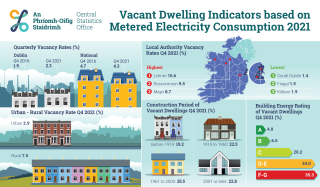Vacant Dwelling Indicators based on Metered Electricity Consumption 2021

A new report from the Central Statistics Office (CSO), 'Vacant Dwelling Indicators based on Metered Electricity Consumption 2021' examines "active network connections with a suitably low level of consumption over four consecutive quarters" and designates these as vacant. This is a different approach distinct from definitions of vacancy which are based usually on a ‘point in time’, such as a Census or property tax figures gathered by Revenue. The CSO caveat the data as due to the limitations of the data, these indicators of vacancy based on the utility data should not be used to measure the number of properties that could potentially be available for reuse.
Main Findings
The vacancy rate across Ireland for dwellings was 4.3 per cent in Q4 2021, based on metered electricity consumption.
In Dublin, 2.3 per cent of dwellings in Q4 2021 were vacant, compared with 5.1 per cent in the rest of Ireland.
On a national level, vacancy rates have fallen from 4.9 per cent from Q1 2016 to 4.3 per cent in Q4 2021. In Dublin, however that trend has reversed, increasing from 1.9 per cent to 2.3 per cent over that same period.
Leitrim was the Local Authority with the highest vacancy rate at 10.6 per cent in Q4 2021. Roscommon and Mayo follow with 9.5 per cent and 8.7 per cent respectively.
The lowest vacancy rates were in to be found in South Dublin at 1.4 per cent, Fingal and Kildare both come next at 1.9 per cent.
Swinford in Mayo was the Local Electoral Area (LEA) with the highest percentage of vacant dwellings, 12.2 per cent, in Q4 2021 while the lowest was in Leixlip, Kildare and Tallaght Central, Dublin, both at 0.7 per cent.
The vacancy rate for rural areas at 7.5 per cent was more than double that of the 2.9 per cent rate in urban areas in Q4 2021.
The vacancy rate for apartments was 3.7 per cent in Q4 2021, 3.2 per cent for detached houses, 2.9 per cent for terraced houses, and 1.8 per cent for semi-detached houses. The CSO note that "this analysis was only available for dwellings with a Building Energy Rating (BER").
Close to two in ten (19.2 per cent) of vacant dwellings in Q4 2021 with BER assessments were constructed prior to 1919 while more than four in ten (41.7 per cent) were built prior to 1960.
Policy Priorities to tackle Vacancy
In early 2017, the Government introduced the Repair and Leasing Scheme for owners of vacant properties to access funding of up to €40,000 to repair their properties which would then be leased to the local authority for use as social housing for a term of between five and 20 years, with a target of 3,500 properties to be brought back into use. The latest data from the Department indicates that of the 2,168 applications made, just 227 leases were signed in respect of 273 properties.Just over one in ten applications resulted in a lease. This is clearly not working.
The Housing for All Strategy committed to the introduction of a new vacant land tax to replace the Vacant Site Levy. This was introduced in Budget 2022, however at a rate of 3 per cent, and with a lead-in time of 3 years, this will have little impact. This disappointing lack of progress begs the question of whether Government is really serious about addressing vacancy in a meaningful way.
Allowing vacancy in the middle of a housing crisis cannot continue. Social Justice Ireland regrets that Government missed the opportunity to introduce a Site Value Tax in Budget 2023, as proposed by Social Justice Ireland and recommended by the Commission on Taxation and Welfare.